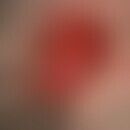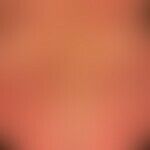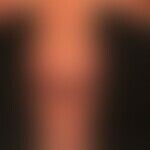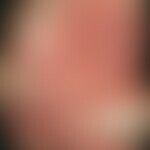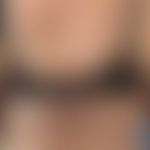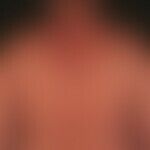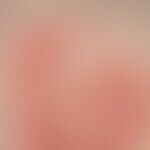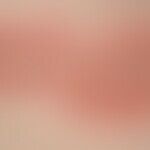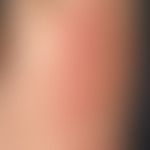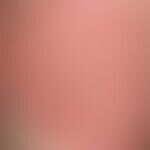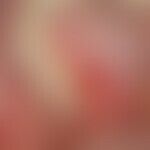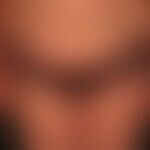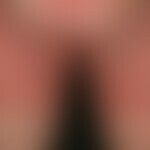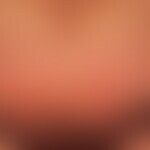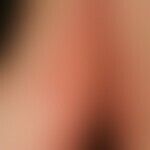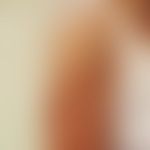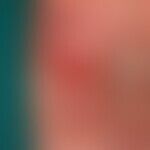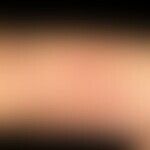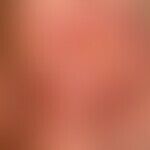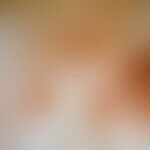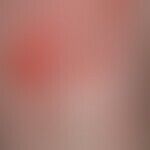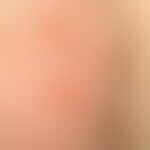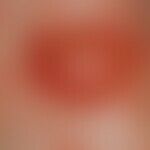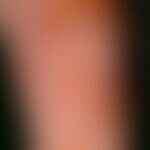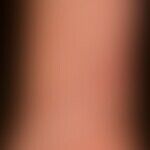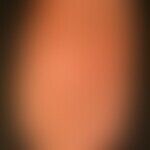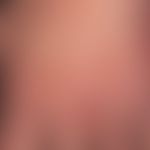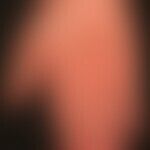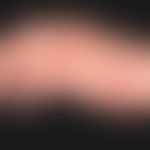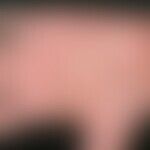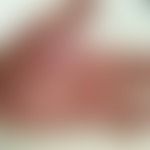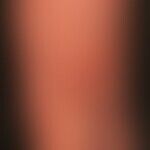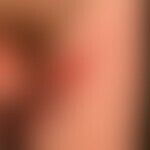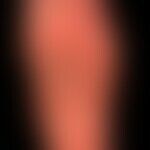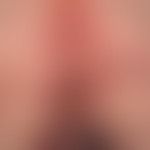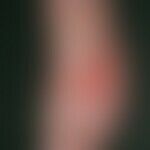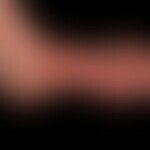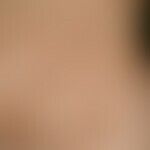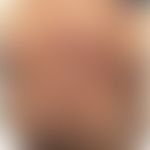Synonym(s)
HistoryThis section has been translated automatically.
DefinitionThis section has been translated automatically.
Localized or exanthematic, blistering autoimmune disease of the skin and mucous membrane (mucosal infestation rather rare) of the elderly with subepidermal blistering.
You might also be interested in
ClassificationThis section has been translated automatically.
Clinical variants of bullous pemphigoid.
- Localized bullous pemphigoid (e.g. localized pretibial bullous pemphigoid)
- Scarring pemphigoid type Brunsting-Perry
- Vegetating bullous pemphigoid (pemphigoid vegetans: chronic vegetating and weeping lesions mainly in intertriginous skin areas, but also in the facial area)
- Non-inflammatory phenotype of bullous pemphigoid
- Pemphigoid gestationis (pregnancy pemphigoid)
- Seborrhoeic pemphigoid (mainly affects older women, localization = anterior and posterior sweat duct)
- Vesicular bullous pemphigoid (reminiscent of dermatitis herpetiformis)
- Dyshidrosiform bullous pemphigoid (picture of dyshidrosis palmoplantaris, rarely blisters on the rest of the body; mostly older patients; otherwise identical immunological findings)
- Juvenile pemphigoid (bullous pemphigoid of childhood; frequent involvement of the palms of the hands and soles of the feet, also involvement of the oral mucosa)
- Mucocutaneous bullous pemphigoid (10-20% of BP cases - oral/genital/nasal mucosa)
- Erythrodermic bullous pemphigoid (very rare form that can occur after UV therapy)
- Nodular pemphigoid (occurrence of itchy nodules in addition to blisters)
- Bullous pemphigoid under the picture of prurigo simplex subactua
- Paraneoplastic bullous pemphigoid
- Drug-induced bullous pemphigoid (see also under irAE)
Occurrence/EpidemiologyThis section has been translated automatically.
Most frequent blistering autoimmune dermatosis. Incidence: 6-7/100.000 inhabitants/year. With increasing age, the incidence rises from about 10/100,000 inhabitants/year for 60-year-olds to over 40/100,000 inhabitants/year for 90-year-olds. There are indications that incidences have increased by a factor of 2-3 in the last 20 years.
Bullous pemphigoids are more frequently found in autoimmune diseases, e.g. polymyositis, ulcerative colitis, chronic polyarthritis (rheumatoid arthritis).
EtiopathogenesisThis section has been translated automatically.
The aetiopathogenesis of the disease is unknown.
Bullous pemphigoid is an autoimmune disease with the formation of mainly IgG (IgG1 and IgG4 subclasses) and (more rarely) IgE autoantibodies: targets are hemidesmosomal antigens. The antibodies are directed against several antigens of the dermo-epidermal junction zone:
- bullous pemphigoid antigen 2 (BP180; bullous pemphigoid 180-kDa protein, also known as collagen type XVII (-see also COL17A1 gene) or BPAg2.
- Bullous pemphigoid antigen 1 (BP230; bullous pemphigoid 230-kDa protein, also known as BPAG1 or dystonin ).
- Laminin 5: The alpha3 and gamm2 subunits are the main targets of antibodies against laminin 5 (332). Rare are antibodies against the beta3 subunit. Schelim skin lesions are common in this laminin 5 subtype (Miyahara H et al. 2024)
The formation of the antigen-antibody complexes leads to complement-mediated chemotactic attraction of inflammatory cells or to the release of proteases and inflammatory blister formation, which begin within the ultrastructural lamina lucida.
The hemidesmosomal protein BP180 is considered to be the main autoantigen. It is a transmembrane glycoprotein with a so-called type II orientation (the NH2 terminus is intracellular, the -COOH terminus is extracellular). The parts of the extracellular terminus (NC161 domain) act as immunodominant sections. The serum level of autoantibodies against the immunodominant NC16A domain of BP180 correlates with the disease activity of the disease. Antibodies against BP 180 can be detected in around 90 % of BP patients.
BP230 (BPAg1) is located intracellularly and is part of the hemidesmonsomal plaque. Its carboxyl end binds to keratin filaments. IgG anti-BP230 antibodies are found in around 70 % of patients (Ishiura N et al. 2008). BP230 mediates the binding of keratin intermediate filaments to the hemidesmosomal plaque at the molecular level. The autoantibodies against BP230 can not only trigger inflammatory reactions in vivo, but also impair the structural stability of the hemidesmosomes (Shih YC et al. 2020). Consistent with this is the finding that a small subpopulation of BP patients selectively exhibit autoantibodies only against BP230 (Ramcke T et al. 2022). The importance of this antibody is also emphasized by the fact that IgG anti-BP230 antibodies tend to increase in proportion to the increase in disease duration.
IgE anti-BP180 antibodiesare found in around 30% of patients and IgE anti-BP230 antibodies in around 65% (Hashimoto T et al. 2017). The IgE anti-BP230 values show a strong association with the local accumulation of eosinophils (Ishiura N et al. 2008).
More rarely, the disease occurs as a paraneoplastic syndrome (paraneoplastic bullous pemphigoid), e.g. in prostate carcinoma, rectal carcinoma, bronchial carcinoma (Giacaman A et al. 2018).
It remains to be seen to what extent Helicobacter pylori infections can be assessed as provocation factors. In individual cases, long-term remissions were detectable after eradication (Abu Rached N et al. 2025).
The following medications and therapeutic procedures are described as triggers of bullous pemphgoid, although less frequently than in pemphigus: ACE inhibitors (e.g. Captopril, enalapril), amoxicillin, ampicillin, anti-PD/PDL1 inhibitors, cephalexin, diazepam, DPP-4 inhibitors, etanercept, locally applied 5-fluorouracil, furosemide, anticoagulants (direct Factor Xa inhibitors such as rivaroxaban), anticoagulants (direct Factor Xa inhibitors such as rivaroxaban).e.g. rivaroxaban), gold preparations, NSA (e.g. ibuprofen), penicillamine, penicillin V, salazosulfapyridine, sulfasalazine, sulfonamides and derivatives, terbinafine, photodynamic therapy, pembrolizumab (see also under immune checkpoint inhibitors). DPP-4 inhibitors lead to BP in about 0.02% of patients. Since the side effects occurred with each of the DDP-4 inhibitors, this side effect can be projected to the entire substance group (Phan K et al. 2020).
Drug-induced BP shows great clinical variability. It can appear as classic BP, erythema multiforme or bullous drug exanthema. The skin changes begin within weeks to months after starting the medication. The symptoms subside after discontinuation of the medication. The serological and immunofluorescence microscopic findings are unchanged compared to classic BP.
Triggering by UV radiation (UVB, UVA/PUVA), PUVA therapy and X-rays is well documented and a genetic predisposition to the disease is associated with the haplotype HLA-DQB1*0301.
The observation that cerebral apoplexy increases the incidence of bullous pemphigoid is noteworthy (Braun-Falco M 2018). An analogous constellation was found for schizophrenia but not for anxiety disorders (Huang ICH et al. 2022).
ManifestationThis section has been translated automatically.
Occurs at an advanced age, usually after the beginning of the 6th decade. Rarely begins in childhood.
LocalizationThis section has been translated automatically.
Mainly trunk, armpits, flexor sides of the upper arms, umbilical region, inner thighs. Less frequently, the palms of the hands/soles of the feet or the mucous membranes are involved (approx. 10-12% - Ständer S et al. (2021) .
ClinicThis section has been translated automatically.
Frequent: Multifaceted, variegated clinical picture with blistering on the flexor sides of the extremities and trunk and intense pruritus. The subepithelial, turgid blisters, which occur in episodes, do not develop on unchanged skin but on red, extensive erythema or urticarial plaques. They are often localized at the edges. After the blisters burst, erosions or crusts develop on erythematous skin. Healing without scarring or milia formation. Newly formed blisters are typically found next to healing blisters; this results in a variegated coexistence of different stages of development of pemphigoid efflorescences.
Nikolski phenomenon I is negative (important diagnostic phenomenon to exclude pemphigus vulgaris).
In contrast, Nikolski phenomenon II (lateral displacement of preexisting blisters) is positive; however, this phenomenon is very nonspecific for bullous dermatoses.
Oral mucosal changes (rather rare but possible): Usually no blisters detectable but only sharply demarcated erosions (blisters burst rapidly due to the high mechanical stress in the oral cavity). Low healing tendency of the erosions.
Rare: In a few cases, the clinically groundbreaking blisters do not form. Thus, the clinical leading symptom "bulging (firm) blister" and the clear clinical assignment to the blister-forming diseases is omitted. Instead, a clinical picture with severe, therapy-resistant pruritus, with extensive erythema or plaque appears. However, eczematous, urticarial or Purigo-like skin changes may also occur.
Patients with bullous pemphigoid have an increased association with neurologic disorders, which may increase mortality. Neurologic disorders preceded bullous pemphigoid in the majority of cases with a median time interval of 6.7 years . Patients with BP had a significantly higher risk of apoplexy, dementia, epilepsy, multiple sclerosis, Parkinson's disease (Lai YC et al. 2016)
HistologyThis section has been translated automatically.
Histologically, 2 variants of bullous pemphigoid are distinguished:
- Cell-rich variant: Subepidermal blistering with marked inflammatory infiltrate at the edematous blister base and in the blister lumen, consisting of numerous eosinophilic leukocytes, lymphocytes, and neutrophilic leukocytes.
- Cell-poor variant: Subepidermal blister formation with intact papillae and little to no inflammatory infiltrate (it is conceivable that the blister contents in the noninflammatory variant are more like transudate than exudate).
Biopsy of a pre-blister stage (urticarial infiltrate), with edematous papillary body and dilated blood and lymphatic vessels, reveals a focal, mixed-cell, epidermotropic infiltrate of lymphocytes, numerous eosinophils, and scattered neutrophilic leukocytes. A diagnostically valuable sign is the linear arrangement of leukocytes and also nuclear debris at the dermo-epidermal junctional zone. Less frequently, eosinophilic subcorneal microabscesses are found.
Remark: For technique of sampling see also below Pemphigus vulgaris.
Direct ImmunofluorescenceThis section has been translated automatically.
The diagnosis of bullous pemphigoid can be confirmed immunohistologically in conjunction with the clinical manifestations and the serological findings (this diagnostic method is highly relevant!).
In perilesional skin, in descending frequency, detection of C3 (94% of pat.), IgG (79%), IgM and IgA (each < 20%) linear at the dermoepidermal junction zone. Linear IgM detections at the basement membrane may be associated with macroglobulinemia.
Perilesional biopsy is important! Biopsy of a bladder may result in a false positive (Ig and C3 deposited nonspecifically) or a false negative finding (Ig/C3 proteolytically degraded, or the bladder roof does not present at all for technical reasons). A preference for a specific body region is not recommended diagnostically.
Indirect immunofluorescenceThis section has been translated automatically.
Pemphigoid antibodies: circulating anti-basal membrane antibodies of the IgG class in 80-90% of patients. Here the most sensitive substrate is human split skin. By immunoprecipitation and immunoblotting the autoantibodies bind mainly to the autoantigens BP 180 and BP230. 125 kDa dermal protein requires further characterization.
In 5-10% of patients circulating IgA antibodies are found on the epidermal side.
In the so-called salt split skin examination there is a reaction of antibasal membrane antibodies with the epidermal part of the bladder (bladder cover).
The titers of indirect immunofluorescence do not correlate with the disease activity.
Differential diagnosisThis section has been translated automatically.
Pemphigus vulgaris and other blistering dermatoses
Erythema anulare centrifugum: Multiple, initially homogeneous 1.0-2.0 cm red plaques which heal centrally and expand centrifugally. The centrifugal growth of the plaques is several millimeters per day. This results in ring formations with a diameter of up to 6.0 cm within a few weeks. These can flow together in several arcs. Blistering is possible. The plaques are typically smooth on the surface. In some cases, a fine lamellar ruff of scales can be found on the inner edge of the ring.
General therapyThis section has been translated automatically.
The therapy should be based on various clinical criteria:
- Age and underlying diseases (e.g. very old age, diabetes mellitus) of the patient.
- Type and trigger of the pemphigoid (e.g. drug-induced, UV radiation or paraneoplastic).
- Acuteness and extent of the disease (generalized or localized, special form of scarring pemphigoid): If the bullous pemphigoid is doubtfully drug-induced, the medication in question should be discontinued or implemented. Neoplastic triggering is controversial, especially as the association with tumors is described, which occur more frequently in the older pemphigoid age group per se.
Remember! "Tumor search"!
External therapyThis section has been translated automatically.
Local therapy should be symptomatic, e.g. with mild antiseptics such as 0.5-2% Clioquinol cream(e.g. Linola-Sept, Clioquinol cream 0.5-2%).
Alternative: Cadexomer iodine (Iodosorb ointment).
Alternative: 1% ethacridine lactate ointment.
The blisters should be opened sterilely.
Note: a randomized study showed that with the large-area external application of clobetasoplpropionate in cream form, (40g/day for 14 days, then gradual reduction) the same positive effects can be achieved as with a systemic applikaiton of prednisolone (0.5mg/kgKg). However, it can be assumed that systemic effects of this highly potent steroid have occurred (Joly P et al. 2002).
Internal therapyThis section has been translated automatically.
In principle, patients with bullous pemphigoid, with the exception of localized bullous pemphigoid, require internal glucocorticoids such as prednisolone (e.g. Decortin H) initially 80-100 mg/day combined with potent steroid-sparing immunosuppressants such as azathioprine (e.g. Imurek Filmtbl.) 100-150 mg/day.
In bullous pemphigoid of moderate (10-30% body surface area) to severe (>30% KOF) severity, the initial doses of glucocorticoid are 1.5-2.0 mg/kg bw/day prednisone equivalent i.v. Several options are possible as an adjunctive immunosuppressant:
- Azathioprine is often still the first choice. Dosage depending on TMP activity: 0.5-2.5 mg/kg bw/day. Preventive gastric protection with an aluminum-containing antacid such as magaldrate (e.g. Riopan 2-4 tablets or 2-3 sachets). General guidelines for intensive care in severe cases correspond to those for pemphigus vulgaris.
- Once the condition has stabilized, the glucocorticoid dose can be gradually reduced while the azathioprine dosage remains unchanged. The glucocorticoid is administered orally from a dose of < 50 mg prednisone equivalents (gastric protection with antacid) and reduced by 5 mg daily. The aim is to achieve a glucocorticoid dose around or below the Cushing's threshold (for 16-alpha-methylprednisolone < 8 mg/day p.o.). Instead of non-halogenated prednisone/prednisolone, a chlorinated glucocorticoid can also be used, e.g. cloprednol (Syntestan) in a continuous dose of 1.25-2.5 mg/day).
Further course:
After 5-7 months, an attempt can be made to discontinue immunosuppressive therapy under close clinical supervision (first discontinue immunosuppressant, e.g. azathioprine, then gradually discontinue the glucocorticoid if the recurrence continues to clear).
In case of relapse, restart with medium-high immunosuppression (prednisone equivalent 0.5-1.0 mg/kg bw/day p.o. and azathioprine 1.0-1.5 mg/kg bw/day p.o.).
Other immunosuppressive options are:
- Dapsone (1.5mg/kg bw/d p.o. monotherapy or adjuvant to systemic glucocorticoids)
- Doxycycline (200mg/d p.o. monotherapy possibly in combination with nicotinamides (up to 2g/d) or adjuvant to systemic glucocorticoids)
- Methotrexate (up to 20mg s.c. per week, monotherapy or adjuvant to systemic glucocorticoids)
- Mycophenolate mofetil (Cellcept®, 2g/d p.o., children 15-30mg/kg bw/d).
Can be used as an alternativein cases of resistance to therapy :
- - IVIG: In smaller studies, good experience has been reported with high-dose i.v. immunoglobulin therapy (e.g. Intratect as monotherapy). Dosage: 2.0 g/kg bw/day spread over 3 days, monthly therapy cycles (high therapy costs!). According to our own experience, combinations with glucocorticoids or immunoadsorption are usually necessary.
- - Immunoadsorption/plasmapheresis.
- - Anti-CD20 antibody(rituximab, monoclonal chimeric human-mouse antibody against the CD20 antigen, which is expressed by immature and mature B cells, but not by plasma cells)
- Dupilumab (human monoclonal antibody, anti-IL-4, anti-IL-13)
Positive results have also been described in the literature with:
- - Cyclophosphamide (2mg/kg bw/d p.o.)
- - Anti-IgE antibodies(omalizumab)
Progression/forecastThis section has been translated automatically.
Chronic, intermittent course. Mortality without therapy is about 20%-40% (!) in the first year and is 2-3 times higher (mostly secondary infections) than in the comparable age group. Here, it is less the extent of the skin symptoms than the multimorbidity of the patients that is decisive.
Note(s)This section has been translated automatically.
Associations with neurological diseases such as: dementia, Parkinson's disease, epilepsy, multiple sclerosis have been described (Kipsgaard L et al. 2017).
Type XVII collagen is encoded by the COL17A1 gene. Unlike most collagens, collagen XVII is a transmembrane protein, a structural component of hemidesmosomes and multiprotein complexes at the dermal-epidermal basement membrane zone that mediate keratinocyte adhesion to the underlying membrane.
Diseases associated with the COL17A1 gene include:
- Epithelial recurrent erosive dystrophy, a very rare congenital form of superficial corneal dystrophy.
and
LiteratureThis section has been translated automatically.
- Abu Rached N et al. (2025) Helicobacter pylori infection an underestimated trigger of bullous pemphigoid? J Dtsch Dermatol Ges 23:97-99.
- Ahmed M et al. (2023) A Case of Bullous Pemphigoid in a Five-Month-Old Female: A Rare Presentation. Cureus 15:e42871
- Balakirski G et al (2014) Bullous pemphigoid. Dermatology 65: 1013-1016
- Borradori L et al. (2022) Updated S2 K guidelines for the management of bullous pemphigoid initiated by the European Academy of Dermatology and Venereology (EADV). J Eur Acad Dermatol Venereol 36:1689-1704.
- Braun-Falco M (2018) Bullous pemphigoid triggered by stroke. Karger compass Dermatol 6:19-20
- Feliciani C et al. (2015) Management of bullous pemphigoid: the European Dermatology Forum consensus in collaboration with the European Academy of Dermatology and Venereology. Br J Dermatol 172:867-877
- Ferreira C et al. (2018) Bullous Pemphigoid-like Skin Eruption during Treatment with Rivaroxaban: A Clinical Case Study. Eur J Case Rep Intern Med 5:000724.
- Fisler RE et al. (2003) Childhood bullous pemphigoid: a clinicopathologic study and review of the literature. Am J Dermatopathol 25: 183-189
- Giacaman A et al. (2018) Anular paraneoplastic bullous pemphigoid mimicking linear IgA dermatosis in a 40-year-old patient.J Dtsch Dermatol Ges 16:481-483.
- Hashimoto T et al. (2017) Detection of IgE autoantibodies to BP180 and BP230 and their relationship to clinical features in bullous pemphigoid. Br J Dermatol 177:141-151.
- Huang ICH et al. (2022) Association between bullous pemphigoid and psychiatric disorders: A systematic review and meta-analysis. J Dtsch Dermatol Ges 20:1305-1314.
- Ishiura N et al. (2008) Serum levels of IgE anti-BP180 and anti-BP230 autoantibodies in patients with bullous pemphigoid. J Dermatol Sci 49:153-161.
- Jackson SR et al. (2020) Paraneoplastic bullous pemphigoid - A sign of clear cell renal carcinoma. Urol Case Rep 30:101119.
- Joly P et al (2002) Bullous Diseases French Study Group. A comparison of oral and topical corticosteroids in patients with bullous pemphigoid. N Engl J Med 346:321-327.
- Kibsgaard L et al. (2017) Increased frequency of multiple sclerosis among patients with bullous pemphigoid: a population-based cohort study on comorbidities anchored around the diagnosis of bullous pemphigoid. Br J Dermatol 176:1486-1491.
- Lai YC et al. (2016) Bullous pemphigoid and its association with neurological diseases: a systematic review and meta-analysis. J Eur Acad Dermatol Venereol 30: 2007-2015
- Lever WF et al (1953) Pemphigus. Medicine 32: 2-123
- Miyahara H et al. (2024) Pemphigoid without mucous involvement showing IgG antibodies to the β3 subunit of laminin-332. J Dtsch Dermatol Ges 22:570-573.
- Phan K et al. (2020) Dipeptidyl peptidase-4 inhibitors and bullous pemphigoid: A systematic review and adjusted meta-analysis. Australas J Dermatol 61e: 15-e21.
- Powell AM et al. (2002) Pemphigoid nodularis (non-bullous): a clinicopathological study of five cases. Br J Dermatol 147: 343-349
- Ramcke T et al. (2022) Bullous pemphigoid (BP) patients with selective IgG autoreactivity against BP230: Review of a rare but valuable cohort with impact on the comprehension of the pathogenesis of BP. J Dermatol Sci 105:72-79.
- Rose C et al. (2007) Histopathology of anti-p200 pemphigoid. Am J Dermatopaphol 29:119-124
- Sami N et al. (2003) Influence of intravenous immunoglobulin therapy on autoantibody titres to BPAG1 and BPAG2 in patients with bullous pemphigoid. JEADV 17: 641-645
- Schmidt E et al. (2000) New aspects on the pathogenesis of bullous pemphigoid. Dermatology 51: 637-645
- Schmidt E et al. (2015) S2k guideline for the diagnosis of pemphigus vulgaris/foliaceus and bullous pemphigoid. JDDG 13: 713-726
- Scholz J et al (2010) IgM-induced bullous pemphigoid in Waldenström's disease. JDDG 8: 952
- Schulze F et al (2013) Bullous pemphigoid. Dermatology 64: 931-945
- Shih YC et al (2020) Role of BP230 autoantibodies in bullous pemphigoid. J Dermatol 47:317-326.
- Ständer S et al. (2021) Immunologic characteristics and factors associated with mucocutaneous bullous pemphigoid - a retrospective cohort study.
- Szymanski K et al. (2022) Case Report: Pemphigoid Nodularis-Five Patients With Many Years of Follow-Up and Review of the Literature. Front Immunol 13:885023.
- Wojnarowska F et al. (2002) Guidelines for the management of bullous pemphigoid. Br J Dermatol 147: 214-221
- Yu-Yang S et al. (2017) Bullous Pemphigoid Masquerading as Erythema Annulare Centrifugum. Acta Dermatovenerol Croa 25: 255-256.
Incoming links (59)
Acquired haemophilia A;; Agesemphigus; Autoimmune dermatoses, bullous; BTK inhibitors and autoimmun diseases; Bullosis diabeticorum; Bullous pemphigoid; Chronic prurigo; Ciclosporin a; Clioquinol cream 0.5-2% (o/w); COL17A1 gene; ... Show allOutgoing links (52)
Ace inhibitors; Amoxicillin; Ampicillin; Antiseptic; Autoimmune diseases; Azathioprine; Blistering skin diseases (overview); Bullous Pemphigoid ; Cadexomer iodine; Clioquinol; ... Show allDisclaimer
Please ask your physician for a reliable diagnosis. This website is only meant as a reference.


